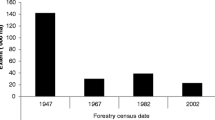Abstract
The Gallatin Petrified Forest of Montana, USA, is a unique resource. The extensive area of the fossil forests, the numerous petrified trees in upright positions, and the large number of vertical layers of “successive” forests are unparalleled in the world. Collection by permit is permitted, but damage to the petrified forest by indiscriminate collection occurs. To assess the impact, a comparative examination of replicate (over 13 yr) photography of selected specimens was undertaken. The amount of change over time, the possible cause of change, and the relationship of the location of the specimen to that amount of change were determined. It was found that although considerable loss continues, impacts prior to a 1973 collection policy were most severe. There was more loss by natural erosion than by collection, but the collections are additive to the natural changes. Size of petrified outcrops and the steepness of the slope on which they were found did correlate with the amount of natural change occurring over time. Human-induced change was associated with the distance of the outcrops from the main trailheads and the specimen size. This method provides a tool with which to monitor impacts and develop a future policy aimed towards conservation of a unique resource in light of the need for appreciative recreation and some specimen collection. Recommended changes in present management policy are provided.
Similar content being viewed by others
Literature Cited
Chapman, W., and L. Chapman. 1935. The petrified forest.Natural History 35:382–393.
Dorf, E. 1964a. The petrified forests of Yellowstone Park.Scientific American 210:105–114.
Dorf, E. 1964b. Petrified forests of Yellowstone National Park. National Park Service. US Government Printing Office, Washington, DC.
Dorf, E. 1980. Petrified forests of Yellowstone National Park. National Park Service. US Government Printing Office, Washington, DC.
Fisk, L. H. 1976. The Gallatin “petrified forest”: A review. Montana Bureau of Mines and Geology Special Publication 73, The Tobacco Root Geological Society 1976 Field Conference Guidebook, Montana College of Mineral Science and Technology, Butte, Montana.
Knowlton, F. H. 1899. Fossil flora of the Yellowstone National Park.US Geological Survey Monograph 32:651–791.
Ritland, J. H. 1968. Fossil forest of the Specimen Creek area, Yellowstone National Park, Montana. Unpublished MA thesis. Andrews University, Berrien Springs, Michigan.
Sanborn, W. B. 1951. Groves of stone: Fossil forest of the Yellowstone region.Pacific Discovery 4:18–25.
Soil Conservation Service. 1981. Average annual precipitation, Montana. US Department of Agriculture, Bozeman, Montana.
Sollid, S. A. 1973. Surficial geology of the Porcupine drainage basin, Gallatin County, southwestern Montana. Unpublished MS thesis. Montana State University, Bozeman, Montana.
US Forest Service. 1973. Gallatin petrified forest special management zone permit and regulations. US Department of Agriculture, Bozeman, Montana.
Wilbur, J. R. 1990. Change assessment of the Gallatin petrified forest, Montana. Unpublished MS thesis. Montana State University, Bozeman, Montana, 103 pp.
Author information
Authors and Affiliations
Rights and permissions
About this article
Cite this article
Wilbur, J., Hansen, K. Change in a petrified forest and implications towards management. Environmental Management 16, 179–186 (1992). https://doi.org/10.1007/BF02393823
Issue Date:
DOI: https://doi.org/10.1007/BF02393823




